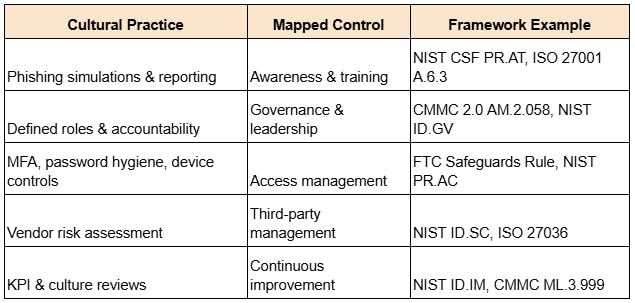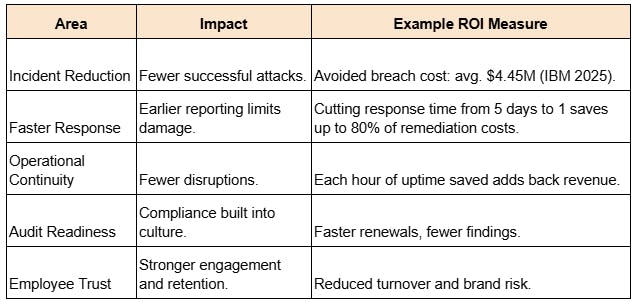How to Embed Cybersecurity Into Your Company Culture

Our CISO at Consilien says, “Cybersecurity isn’t a department. It’s a mindset.”
Cybersecurity tools and firewalls do their job, but the choices employees make every day are ultimately the choices that determine whether your company stays protected or not.
Phishing clicks, rushed approvals, unsecured files… these are cultural habits, not system flaws. And while awareness training has its place, awareness alone doesn’t change behavior.
Culture does.
A strong cybersecurity culture means that secure habits are woven into how your company operates. They’re not added on as another checklist item. When employees instinctively pause before clicking a link, managers ask about data handling in meetings, and leaders model accountability from the top down, you have a culture of cybersecurity.
In short, culture is the new perimeter. And without it, even the best technology leaves gaps wide enough for attackers to exploit.
Why Cybersecurity Culture Is the New Perimeter
Technology protects systems. Culture protects decisions.
Most breaches still involve a human factor. Not because people don’t care, but because organizations treat cybersecurity as a training issue, not a cultural one.
Consilien’s CISO says this often, “the strongest security tool you have is an aware workforce”.
In a world with remote work, AI phishing threats, and rising compliance demands, culture is your strongest control. What people do when no one is watching, how teams respond when something feels off, and how leaders set expectations… is your culture.
When cybersecurity shifts from being a burden to a reflex, risk drops and resilience rises.
Leadership Drives Culture. Not IT.
Cybersecurity culture doesn’t come from more policies or longer training modules. It comes from example.
Employees mirror what executives model. If leaders look at cybersecurity as simply “IT’s job,” that message spreads to the team as well. But when leadership visibly prioritizes cybersecurity, by asking about metrics in meetings, sharing lessons learned, and supporting security investments, it signals that protecting the business is everyone’s responsibility.
Board and Executive Accountability
Strong culture starts in the boardroom.
Cyber risk should be prioritized alongside financial and operational risk in every quarterly review. Executives should own and track cybersecurity KPIs, like incident response time, employee reporting rates, or policy adherence, so accountability doesn’t stop at the CISO.
When boards track cybersecurity as a business metric, it becomes part of organizational health, not just a compliance chore.
Psychological Safety: Create a “Report Without Fear” Culture
If someone clicks a phishing link or misconfigures access, the first response shouldn’t be blame, it should be gratitude. Transparency turns mistakes into early warnings.
At Consilien, we’ve seen that companies with open communication and zero-blame reporting identify threats faster and respond with more confidence. That’s culture in action.
Align Policy with Reality
Policies only work if people can follow them.
When rules conflict with how work gets done, like remote access restrictions without good alternatives, people find shortcuts. Aligning policy with reality removes friction and reinforces that security enables business, not restricts it.
The goal: design controls people want to follow because they make sense.
How to Embed Cybersecurity Into Daily Operations
Awareness isn’t enough for today’s threats. James, our CISO at Consilien says, “make security second nature, not second thought”.
To build a lasting cybersecurity culture, security has to live inside daily operations, not just during Cybersecurity Awareness Month or an annual training.
When security is baked into workflows, employees don’t have to remember to act securely, they just do.
Secure Onboarding, Access, and Vendor Management
Start at the source.
When new employees join, security expectations should be as clear as HR policies. Grant access based on role, review it with each change, and remove it when people leave. Apply the same discipline to third party vendors, especially if they have system or data access.
Embedding access reviews into workflows for HR and procurement, builds consistency and prevents human error.
Security Checkpoints in Core Processes
Security shouldn’t be a bottleneck. It should be a quality check.
- Finance: Verify vendor bank changes before processing.
- HR: Handle employee data securely during onboarding and offboarding.
- Operations: Review data-sharing at project kickoffs.
When every department owns part of cybersecurity, accountability spreads horizontally, not just top-down.
Role-Based Microlearning
Employees don’t need more training. They need timely, relevant reminders.
Developers need secure coding prompts. Finance managers should practice spotting invoice fraud. Remote employees benefit from privacy tips for home networks.
Deliver short, contextual micro-lessons through tools people already use… Teams, Slack, or email, so security becomes part of the workflow, not an interruption.
The Behavior Change Blueprint
Changing behavior is much harder than changing tools or changing software.
People know what not to do; they just don’t always do it. That’s the gap between knowing and doing, and it’s where behavior models help. Think of it like muscle memory. Employees need practice and repetition. Habits need to be so routine that they happen automatically.
The Prompt–Ease–Motivation (PEM) Model
At Consilien, we use a simple framework to make secure behavior second nature.

Traditional training depends on motivation, which comes and goes. By adding prompts and making secure actions easy, we turn good intentions into lasting habits.
Recognition Over Retribution
Reward what you want repeated.
A quick thank you in a team meeting or leaderboard recognition for strong security participation drives engagement far more effectively than reprimands ever could.
Integrate, Don’t Isolate
Automate prompts, make reporting simple, and close feedback loops. When employees see the impact of their actions, like a phishing report that prevented an incident, cybersecurity becomes personal.
Measuring What Matters — The Culture KPI Dashboard
You can’t improve what you don’t measure.
Completion rates don’t prove culture. Behavior does.
A Cybersecurity Culture Scorecard gives leadership real visibility into progress.

Track these quarterly to spot trends early.
Use both leading indicators (reporting rates, engagement) and lagging indicators (incident reductions, audit results).
When leadership reviews cultural KPIs like financial ones, employees see that cybersecurity is part of performance, not policy.
90-Day Action Plan to Embed Cybersecurity
You don’t need years to shift culture. A focused 90-day plan builds momentum, trust, and measurable results.
Days 1–30: Set the Foundation
- Leadership pledge and kickoff communication
- Baseline assessment of culture and engagement
- Quick wins: one-click phishing report, companywide MFA, clear reporting channels
Days 31–60: Build Habits
- Launch role-based microlearning
- Recognize teams for proactive reporting
- Nominate “security advocates” across departments
- Simplify and align key policies with reality
Days 61–90: Reinforce and Adjust
- Share the Culture Scorecard results companywide
- Gather feedback and refine programs
- Celebrate wins, share stories, and plan quarterly reviews
Culture grows through small, consistent wins, not one off campaigns.
Technology’s Role- AI as Amplifier, Not Replacement
AI is transforming cybersecurity, both for attackers and defenders.
It’s creating smarter scams- Voice deepfakes, QR code phishing, hyper-personalized emails, and forcing organizations to build sharper instincts, not just stronger firewalls.
When used responsibly, AI can also amplify culture by making training smarter and more personal.

AI should never replace leadership, it should enable it.
Technology can prompt and measure, but people still lead.
Compliance Without Complexity
For most firms, compliance is non-negotiable. But it shouldn’t slow business down.
The key is to align compliance with culture so the same activities that improve awareness also meet regulatory expectations.

Cybersecurity that’s embedded in an organization’s culture naturally produces evidence that auditors want- like testing logs, training records, and incident reports. Without extra work.
When employees understand that compliance protects both the company and themselves, it stops feeling like paperwork and starts feeling like progress.
ROI and Business Impact
Cybersecurity culture delivers measurable business value.
When employees act securely, incidents drop, downtime shortens, and compliance runs smoother.

Culture builds both hard and soft ROI: financial savings and reputation.
It makes security a shared success, not a burden.
FAQs
How is culture different from awareness training?
Awareness tells people what to do. Culture ensures they do it instinctively.
How long does it take to build culture?
Most organizations see change in 3–6 months when leadership and measurement align.
What are signs of progress?
More phishing reports, fewer clicks, faster response times, and employees talking about security naturally.
What if employees resist change?
Listen first. Resistance usually means friction somewhere. Simplify and celebrate small wins.
How do we know it’s working?
Track a mix of behavioral and performance metrics. Share results transparently each quarter.
Find Out More
Building a cybersecurity culture doesn’t happen by accident. It’s something that must be designed, reinforced, and measured.
Consilien can help with your cybersecurity strategy. From Security Awareness Training (SAT) to vCISO services, Consilien offers tailored programs to strengthen cyber posture, embed secure behavior, and meet compliance with confidence.
Visit Consilien to start your culture transformation today.